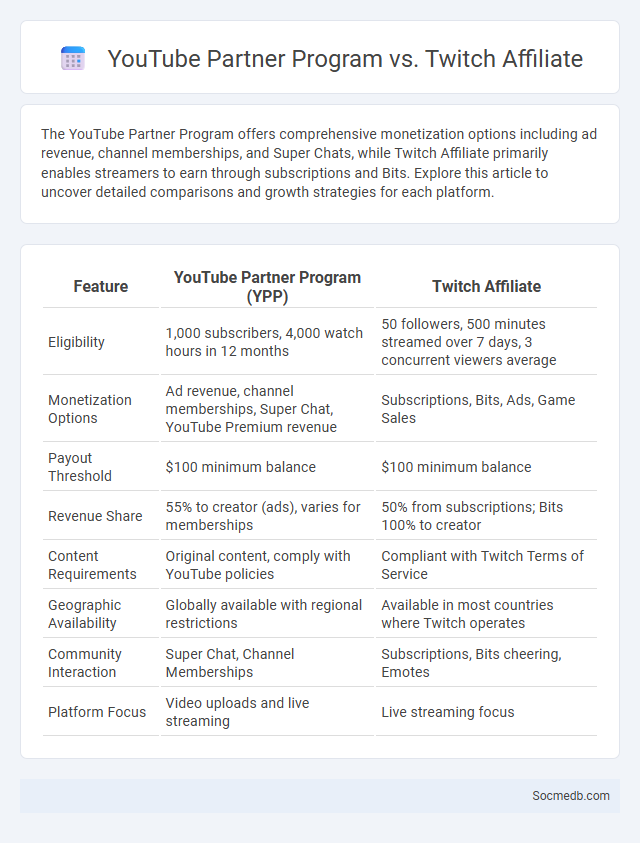
Photo illustration: YouTube Partner Program vs Twitch Affiliate
The YouTube Partner Program offers comprehensive monetization options including ad revenue, channel memberships, and Super Chats, while Twitch Affiliate primarily enables streamers to earn through subscriptions and Bits. Explore this article to uncover detailed comparisons and growth strategies for each platform.
Table of Comparison
| Feature | YouTube Partner Program (YPP) | Twitch Affiliate |
|---|---|---|
| Eligibility | 1,000 subscribers, 4,000 watch hours in 12 months | 50 followers, 500 minutes streamed over 7 days, 3 concurrent viewers average |
| Monetization Options | Ad revenue, channel memberships, Super Chat, YouTube Premium revenue | Subscriptions, Bits, Ads, Game Sales |
| Payout Threshold | $100 minimum balance | $100 minimum balance |
| Revenue Share | 55% to creator (ads), varies for memberships | 50% from subscriptions; Bits 100% to creator |
| Content Requirements | Original content, comply with YouTube policies | Compliant with Twitch Terms of Service |
| Geographic Availability | Globally available with regional restrictions | Available in most countries where Twitch operates |
| Community Interaction | Super Chat, Channel Memberships | Subscriptions, Bits cheering, Emotes |
| Platform Focus | Video uploads and live streaming | Live streaming focus |
Introduction to YouTube Partner Program and Twitch Monetization
The YouTube Partner Program enables content creators to earn revenue through ads, channel memberships, and merchandise shelf integration once they meet eligibility requirements such as 1,000 subscribers and 4,000 watch hours in the past 12 months. Twitch Monetization offers streamers multiple income streams like subscriptions, Bits, and ad revenue, with partner status achieved by meeting criteria including average viewership and consistent streaming schedules. Your engagement and content quality directly impact earning potential across these platforms, making strategic growth essential for sustainable monetization.
Overview of YouTube Partner Program
The YouTube Partner Program enables content creators to monetize their videos through ads, channel memberships, and Super Chat, requiring at least 1,000 subscribers and 4,000 watch hours in the past 12 months. By joining, you gain access to tools such as analytics, copyright management, and monetization options to grow your channel effectively. This program offers a structured pathway for creators to turn their passion into a sustainable income stream on the world's largest video-sharing platform.
Overview of Twitch Affiliate Program
The Twitch Affiliate Program enables content creators to monetize their channels by earning revenue through subscriptions, Bits, and game sales. You can qualify for the program by meeting specific requirements, including streaming at least 8 hours across 7 unique broadcast days and maintaining an average of 3 concurrent viewers within 30 days. This program offers a vital step for growing streamers to generate income and expand their audience on Twitch's interactive platform.
Overview of Twitch Partner Program
The Twitch Partner Program offers content creators advanced monetization options including ad revenue, subscriptions, and bit donations, designed to reward popular and consistent streamers. Partners gain access to custom emotes, priority support, and expanded channel customization tools, enhancing viewer engagement and brand building potential. Eligibility requires meeting specific milestones like 75 concurrent viewers, regular streaming schedules, and community interaction to ensure a committed and growing audience.
Eligibility Requirements: YouTube vs Twitch
YouTube requires users to have at least 1,000 subscribers and 4,000 watch hours in the past 12 months to join the YouTube Partner Program and monetize content. Twitch's eligibility for Affiliate status includes streaming for at least 500 total minutes over seven unique broadcast days and achieving 50 followers. Both platforms mandate adherence to their community guidelines and terms of service to maintain monetization and partnership benefits.
Monetization Features Comparison
Monetization features on social media platforms vary significantly, with YouTube offering ad revenue sharing, channel memberships, and Super Chat while Instagram emphasizes branded content and shopping tags for influencer marketing. TikTok provides creators with the Creator Fund, live gifts, and brand partnerships, making it popular for short-form video monetization. Facebook supports in-stream ads, fan subscriptions, and Stars, creating diverse revenue streams for content creators across video and live formats.
Revenue Models and Payout Structures
Social media platforms generate revenue primarily through advertising models like pay-per-click (PPC), sponsored content, and subscription fees, optimizing income by targeting user demographics and behavior. Influencers and content creators earn through payout structures such as revenue sharing from ads, affiliate marketing commissions, and brand partnerships, which monetize their engagement and reach. Understanding these models helps You maximize earnings by aligning content strategies with platform algorithms and monetization policies.
Tools and Support for Creators
Social media platforms offer a variety of tools and support features designed to empower creators, including analytics dashboards, content scheduling, and monetization options such as ad revenue sharing and fan subscriptions. Advanced features like algorithm-driven audience targeting and collaborative content creation tools enhance engagement and growth opportunities for creators. Educational resources, community forums, and dedicated creator support teams provide ongoing assistance to optimize content strategies and navigate platform policies.
Pros and Cons of Each Program
Facebook offers extensive networking opportunities and targeted advertising but raises concerns over privacy and misinformation. Instagram excels in visual content sharing and influencer marketing, yet it can contribute to social comparison and mental health issues. Twitter provides real-time news updates and public discourse but struggles with harassment and character limits that hinder nuanced conversations.
Which Program is Best for Your Content Strategy?
Choosing the best social media program for your content strategy depends on your target audience, content type, and engagement goals. Platforms like Instagram and TikTok excel in visual storytelling and short-form video, while LinkedIn is ideal for B2B networking and professional content. Analyzing your audience demographics and content performance metrics helps you customize your approach for maximum reach and impact.
 socmedb.com
socmedb.com